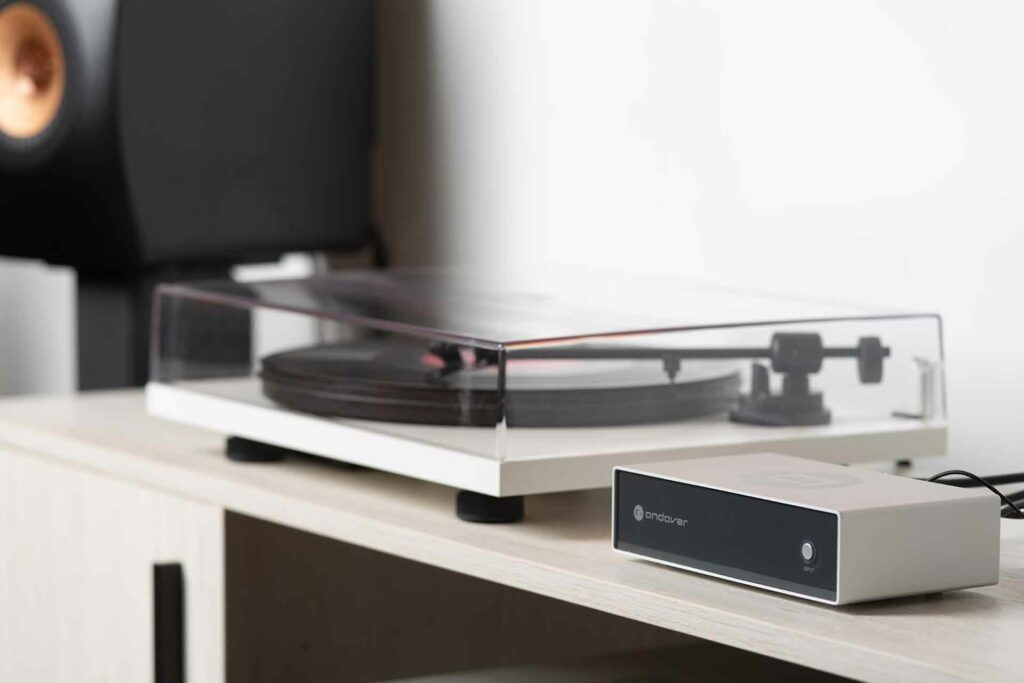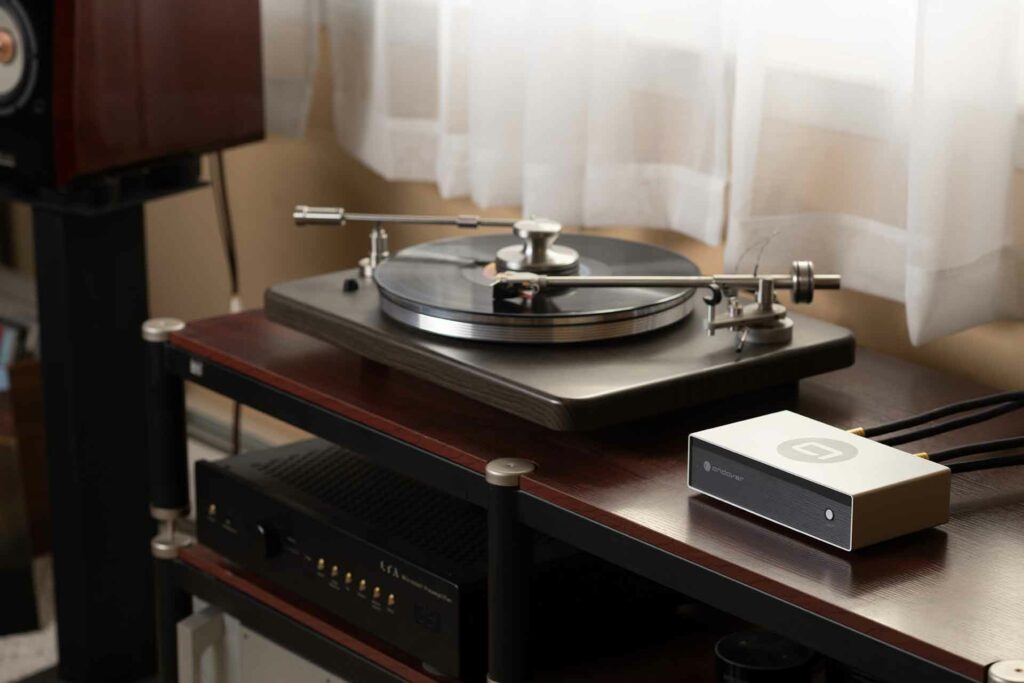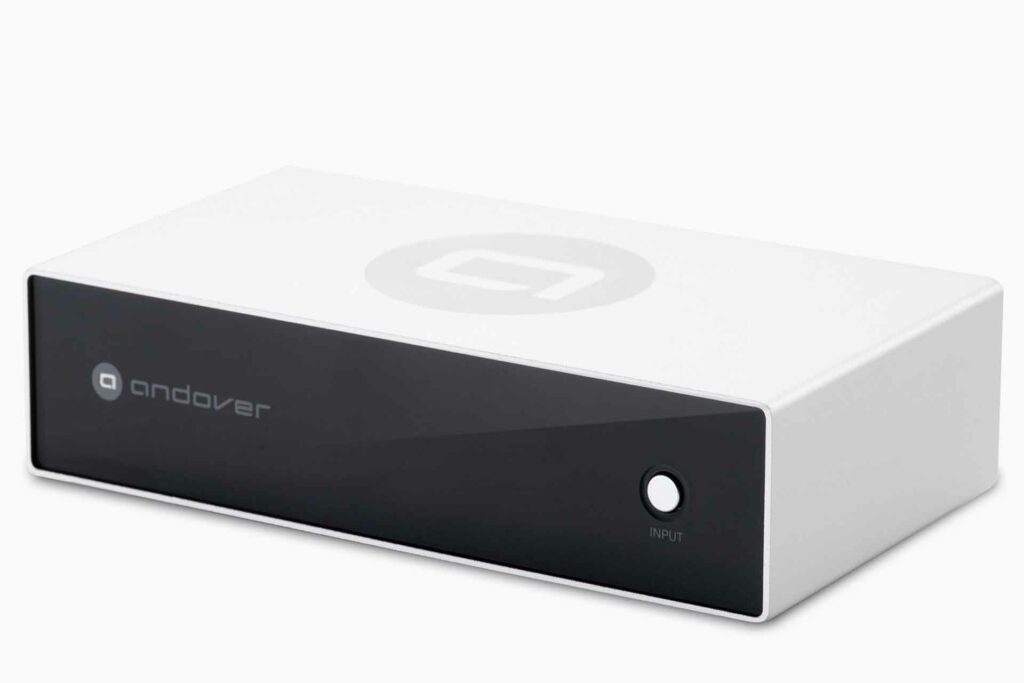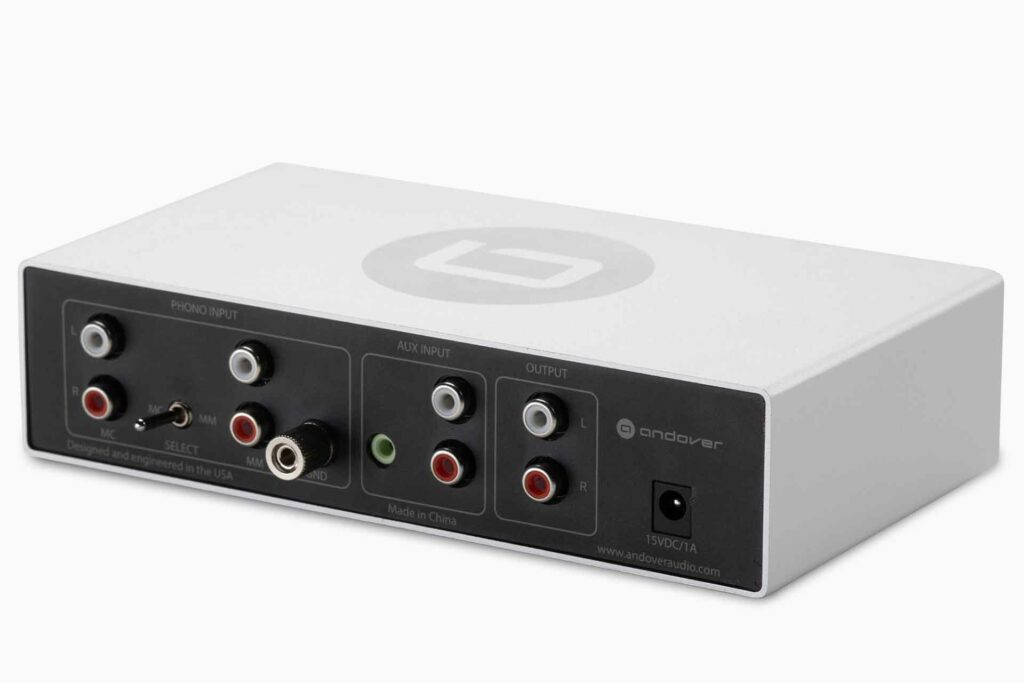If you connect a turntable directly to a line-level input on your integrated amplifier or preamplifier, I guarantee you will be disappointed by the sound. Why? Because the signal from a turntable’s cartridge needs to be boosted and equalized to produce a linear output. The solution if your preamplifier or integrated amplifier lacks a dedicated phono input is a standalone dedicated phono preamplifier. The Andover Audio SpinStage moving magnet/moving coil phono stage (buy at Amazon) is exactly such a solution. For slightly more than many entry-level phono stages that are usually configured for only moving magnet cartridges, which do not require as much gain boost, you can have a standalone phono preamplifier that can handle both moving magnet and moving coil phono cartridges with ease.

What Makes the Andover Audio SpinStage Phono Stage Special?
- In addition to moving magnet and moving coil cartridge inputs, the Andover SpinStage it has a separate line-level analog input. This additional input lets you connect any line-level analog source to your system via the SpinStage, including an audiophile CD player, radio tuner, tape deck, or DAC.
- The SpinStage has provisions for impedance and capacitance adjustments for moving magnet cartridges.
- The SpinStage’s moving coil input is configured to automatically adjust the gain and impedance to match the phono cartridge connected to it. Its moving coil circuit employs a voltage-to-transconductance design that adjusts itself based on your phono cartridge’s output voltage and impedance.
- The SpinStage also includes a subsonic filter. This filter reduces frequencies below 20 Hz. This can eliminate issues caused by warped records, which generate extraneous low-frequency sounds if unfiltered. You can also choose FULLRANGE if you don’t want any truncation of your LP’s low-frequency output.
- The SpinStage employs an outboard power supply. This allows for a smaller chassis. Also, putting the power supply in a separate outboard unit reduces hum issues due to proximity to the power supply.
Why Should You Care About the Andover Audio SpinStage?
While there are many inexpensive phono preamplifiers, most lack the features and sound quality of the Andover Audio SpinStage. With its dual-mono circuit layout and the elimination of any electrolytic coupling caps, the SpinStage was built to perform at a high level. Many phono preamplifiers with a similar set of features and specifications are more expensive, and even expensive phono preamplifiers usually lack a line-level aux input. The inclusion of moving coil cartridge capabilities makes the SpinStage especially attractive, since many analog fans begin their journey with a turntable equipped with a moving magnet cartridge, but when they upgrade to a moving coil cartridge, their phono preamp can’t support the new cartridge. That won’t be an issue with the SpinStage.

Some Things You Might Not Like About the SpinStage Phono Preamp
- The SpinStage will not produce any sound until you select either the FULLRANGE or SUBSONIC filter. The dip switches are located on the bottom of the main chassis. If you are in a hurry to set up the preamp and neglect to set these switches, you might think the SpinStage is broken.
- The SpinStage does have some low-level 60-cycle hum. With most systems, the SpinStage will be quiet enough for normal listening without noticeable hum or buzz unless you turn up the volume substantially above normal listening levels. But if you mate the SpinStage with an especially low output moving coil cartridge, you may hear some low-level hum even at normal listening levels. With its 66.5dB of gain, the SpinStage should interface with all but the lowest-output cartridges with minimal background hum.
Listening to the Andover Audio SpinStage Phono Preamp…
When listening to a turntable system, you must always keep in mind that it is, in fact, a system. You have the turntable motor, the platter (and bearing), the arm, the phono cartridge, the phono preamplifier, and the cables to connect it all together. Any one of these components could be the weak link in the system, so when someone talks about sound quality of a turntable-based audio system, you have to consider the synergistic as well as the potentially pernicious interactions that can occur.
I used the Andover SpinStage with two different turntable systems. The first consisted of a VPI TNT 3 with a Graham 1.5 tonearm mounted with a ClearAudio Virtuoso moving coil cartridge. The second system was a modified VPI HW-19 with an original Souther linear tracking arm mounted with a Denon 103/VanDenHul moving coil cartridge. Cabling from the SpinStage to the line-level input on my Schiit Freya S audiophile solid state preamp was a 10-foot run of Audience AU24 SX. In both systems, the SpinStage provided ample gain to produce more than sufficient volume levels without noise issues. Compared to my reference phono preamplifiers, currently the Vincent Pho-500 and Michael Yee PF-1, I did not find the Andover SpinStage to be a step down, sonically speaking.
Listening to a limited-edition French picture disc of Billie Eilish’s Happier Than Ever album, I was impressed with how good it sounded overall. Picture discs aren’t usually known for great sound due to all the dyes used in the vinyl to make the picture. Not only was the soundstage noticeably wide, but it was also nicely layered, with background singers and voices placed well to the back of the mix. Record noise was slightly higher than I’m used to on a new LP, but neither turntable system had any mis-tracking issues even on the most dynamic sections. Bass extension was good, although there was a bit more midbass and less extreme low bass when compared to the 44.1/16 FLAC file from Qobuz.
One of my longtime favorite albums is a vintage London FFRR copy of Gilbert and Sullivan’s Pirates of Penzance (OSA 1277) performed by the D’oyly Carte Opera Company. Featuring John Reed and the cast who performed during this golden age, this multi-disc set captures the essence of a Gilbert and Sullivan operetta. The SpinStage preserved all the subtle dimensional cues and expansive soundstage of this recording. You can even track the soloists as they move about the stage, while the Royal Philharmonic Orchestra’s accompaniment remains rock solidly in place behind them. Upper frequency instruments such as the flutes and first violins have a wonderful sense of air and delicacy through the SpinStage with both of my turntable systems.
Does the Andover Audio SpinStage Have Any Resale Value?
That would be a big yes, but let me say this: Since the SpinStage can grow with you as you upgrade your phono cartridges, you should be able to keep using it for many years. If and when you do move on to a pricier phono preamplifier, you may end up keeping the SpinStage as a backup, since at 50 percent of retail (the usual used resale price), it may be worth more to you to keep it than sell it.

Who Is the Competition for the Andover Audio SpinStage Phono Preamplifier?
My most recently-reviewed entry-level phono preamplifier was the Vincent Pho-500 ($699), which I have been using as a reference for budget-priced phono preamplifiers ever since the review. But much to my surprise, the Andover Audio SpinStage has most of the Pho-500’s sonic capabilities at less than half the price. The only feature the SpinStage lacks in comparison is the ability to output a digital signal via USB so that it can be directly connected to a computer for the purposes of digitization.
The iFi Zen Phono ($99) is even less expensive option than the Andover SpinStage. I have not heard the Zen Phono, but its features and specifications make it an enticing choice. It even includes a balanced output, subsonic filter options, and four different gain options. Except for its odd shape, it’s hard to find any reasons not to be impressed by the iFi Zen phono.
Pro-Ject has 17 standalone phono preamps among their offerings, ranging from their Pro-Ject Phono Box DS3B ($799) to their Pro-Ject Phono Box E . Pro-Ject Phono Box S2 Ultra ($349) is slightly more money than the SpinStage, and it offers both moving magnet and moving coil capabilities as well as a fully discrete component design, a subsonic filter, variable impedance settings, and two gain settings for moving magnet cartridges, plus two settings for moving coil cartridges.

Final Thoughts on the Andover Audio SpinStage Phono Preamplifier
I’ll let you in on part of my regular review methodology: I sometimes don’t know the prices of the components under review until I sit down to write the review. I’m sharing this with you because after I installed and began listening to the Andover Audio SpinStage , I assumed that its price was twice as much as its current retail. When I finally looked at its price, was I surprised? You bet I was!
I was especially impressed by the automatic impedance adjustment for moving coil cartridges. Some prospective buyers might not like the automatic feature, since they prefer to listen to different impedance settings and make their own decisions as to which one is optimal, but as someone who has probably spent way too much time listening to different impedance settings, I like the idea that this phono preamplifier doesn’t require you to devote hours to necessary tweaking. Just connect it and begin enjoying your LPs. Although the SpinStage has some worthy competition, I seriously doubt that anyone will have second thoughts about purchasing this one and using it for many years to come.




The Zen Phono does not have a balanced output (but does have “balanced circuitry”)
Reviewers need to be coginzant of all technical aspects when reviewing equipment. The fact is you could get away without a phono stage if using a MM cartridge from an output levels only perspective. The main reason one can’t is that the phono stage provides the reverse RIAA equalization curves to the output of the cartridge before it hits the preamp stage. That is the main reason it would sound crappy if connecting to line in inputs on an amp. Line level inputs have no equalization presets.
This sentence, from the opening paragraph, should put your fears at rest – “the signal from a turntable’s cartridge needs to be boosted and equalized to produce a linear output.”